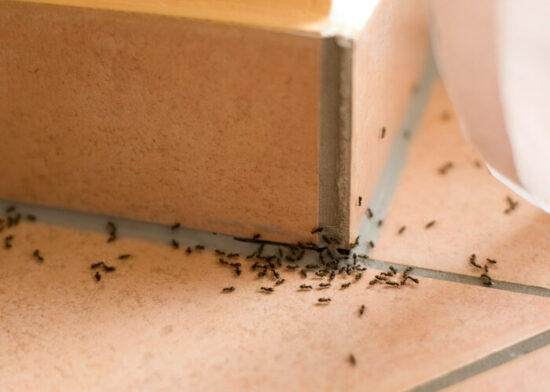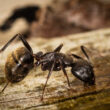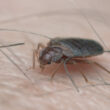No one wants to see ants in their dishwasher. This is where you’re supposed to put dishes to get cleaned, not get crawled all over by pesky little bugs!
Fortunately, learning how to get rid of ants in your dishwasher won’t take long. Once you understand why these insects are in there, it isn’t hard to get them out.
Table of contents
Why Do Ants Go Into Dishwashers?
Seeing ants in your dishwasher can be alarming. You’d think that the mix of heat and intense water pressure would make the appliance inhospitable for these pests. However, ants in the dishwashers are a much more common occurrence than many realize.
Ants are constantly searching for food and water. Even after they have an established colony that flourishes, there’s always a demand for sustenance.
And dishwashers have it all.
Even after a drying cycle, the inside chamber usually has some drops of water that these bugs can lap up. If there’s no water on the dishes and racks, they can always turn to the drain to find some hydration.
- Kills common household ants including acrobat, crazy, ghost, little black, odorous house, pavement, and other sweet-eating ants
- As worker ants discover the bait, they share it with the rest of the colony to eliminate them all
- You should see a significant decrease in the number of ants visiting the bait stations within just a few days
- Place stations near areas where you’ve seen ant activity
Food is abundant as well. Dishwashers are a feat of modern engineering, but that doesn’t mean that food residue and remnants always wash away.
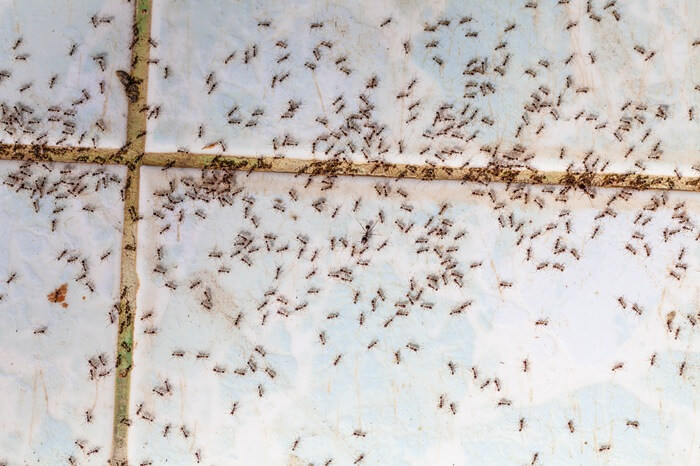
Frequently, residue sticks around for ants and other pests to eat. You may find some on the bottom of the dishwasher chamber, stuck in the filter, or lining the drain. Those remnants are usually nothing more than a sticky, greasy mess. But to hungry ants, it’s the perfect meal!
So, how do ants get into the appliance anyways? By design, dishwashers must have a tight seal. Otherwise, water will get everywhere during a cycle.
Unfortunately, ants can always find a way to get in. Here are two of the most common ways ants end up in dishwashers:
- Many homeowners leave the dishwasher door open longer than they should. Some do it to promote air drying, while others take their time to load dishes in perfectly. Whatever the case may be, those few moments are more than enough for quick ants to crawl right in!
- If they don’t get through the main opening, ants can always use one of the many other entrances. All these insects need is a tiny crack or void. Scouts can make their way under kick plates, through the back of the appliance, and more.
Quick Tip: You may also encounter sewer ants that crawl in from the drain!
No matter where they come from, there’s a good chance that more will follow. Scout ants create pheromone scent trails to attract others. If a few ants successfully find food and water in your dishwasher, it won’t be long until you have a more extensive population to tackle.
How To Get Rid Of Ants In Your Dishwasher
At first sight of ants, you might be inclined to grab a bottle of insecticide spray. But before you do that, take a step back and think about how you use your dishwasher! The last thing you want to do is douse it in chemicals and put yourself and your family at risk.
Getting rid of ants in your dishwasher requires a more systematic approach. Here’s how you can eliminate ants safely and effectively.
1. Use Vinegar & Baking Soda
Vinegar is a fantastic, all-natural pest control solution. The acetic acid serves a couple of purposes.
First, it kills the ants through drowning. But that’s not all. Vinegar can also prevent future ants from ending up in your dishwasher.
You see, vinegar has an intense aroma that ants hate. They naturally avoid it alongside other strong smells. That alone is enough to ward them off in the future.
However, more important is how vinegar deals with scent trails. The pungent smell masks and removes any pheromones, which erases the established path.
To take advantage of all vinegar has to offer, start with about half a cup of baking soda. Baking soda can kill ants and is a strong base that causes an explosive chemical reaction when vinegar is thrown into the mix. The resulting foam works magic the drain pipes, ensuring that even elusive ants get wiped out.
Pour the baking soda into the drain of your dishwasher. Then, pour half a cup of white vinegar. Wait about 10 to 15 minutes as the mixture foams up and wipes the drain clean.
To finish up, pour a pot of boiling water. The water will wipe the mixture away while also removing any stubborn food remnants in the process.
2. Run An Empty Cycle
After you use vinegar and baking soda, it’s time to follow up with an empty cycle.
Take a moment to clean out the drain filter (this might not be pleasant). Then, run the dishwasher without anything in it. You can run the standard hot water cycle.
This process will clean the chamber and get rid of any stubborn ants that survived the vinegar foam. On top of that, the cycle should dislodge any residue.
Quick Tip: If you want to go the extra mile, sprinkle a quarter cup of borax on the bottom of the dishwasher. Not only is borax a great ant killer, but it can break down residue, scour the interior chamber, and leave behind a squeaky clean finish.
3. Find The Source Of The Ants & How They’re Getting In
The work isn’t over after you’ve done your cleaning. While you may have gotten ants out of your dishwasher, there’s nothing stopping others from moving in later on. After you get rid of the existing ants in your dishwasher, you have to figure out where they come from and how they’re getting in.
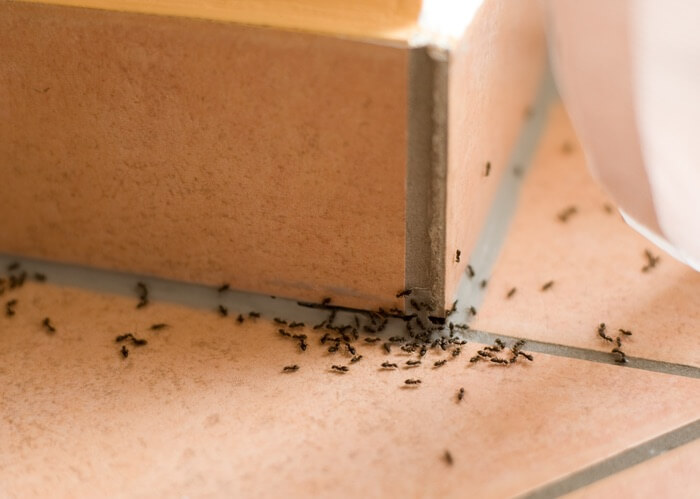
Most ants live outside and crawl into your kitchen in search of food. However, others will set up shop in your walls, floors, and other hidden areas.
Make some time to inspect your home. If you’re lucky, you may see a small trail of ants moving along the floor. Follow the ants to uncover the nest and the entry point. Before the ants ended up in your dishwasher, they started here!
Quick Tip: Even if you don’t see a trail, you’ll likely discover many hiding spots and points of access. Seal all cracks and openings to block future ants from moving in.
4. Clean Up Your Kitchen
There’s a good chance that ants didn’t go into your kitchen exclusively for the dishwasher. In most cases, ants get into your dishwasher after finding food nearby.
Kitchens are rife with opportunities for ants. There are food remnants everywhere! Crumbs, spills, and more can support a growing population without any issues. That’s why so many homeowners need help getting rid of ants in their kitchen.
To prevent ants from getting near your dishwasher altogether, you need to maintain a strict cleaning routine. Clean up all messes and remove anything that could attract ants into the area.
Quick Tip: The scent of food residue is a significant factor for scout ants. While you can’t smell anything on your floors and countertops, these tiny insects can.
Use diluted vinegar to mask any scent. You can also use chemical-based cleaning products or spray solutions with essential oils. Anything with a strong aroma will usually keep ants away while covering any food smells.
5. Set Up Ant Bait
Whether you find the location of nearby nests or not, ant bait traps will come in handy.
- Kills common household ants including acrobat, crazy, ghost, little black, odorous house, pavement, and other sweet-eating ants
- As worker ants discover the bait, they share it with the rest of the colony to eliminate them all
- You should see a significant decrease in the number of ants visiting the bait stations within just a few days
- Place stations near areas where you’ve seen ant activity
Bait works a little differently than contact-based insecticides. These products use a reliable source of food to trick ants into taking it back to the colony. What they don’t know is that the food is laced with slow-acting poison!
The poison can take upwards of 48 hours to kill an ant that consumes the food. By that point, the food is already in the nest where other ants eat it. Over time, bait traps can take out entire colonies. That includes the queen!
You have many bait options. Commercial products are available if you want to keep things simple. However, you can also make your own DIY solution.
Homemade baits give you the chance to customize the recipe based on the ant species you’re trying to kill. Place a few traps near the dishwasher and known scent trails. Then, wait until the ants die!
What To Do If They’re Behind The Dishwasher
It’s not just ants in the dishwasher that you have to worry about. Sometimes, these pests can emerge from behind the appliance.
Typically, finding ants behind the dishwasher means that you’re dealing with an active nest inside your home. They’re residing in your walls or floors, making treatment a little more challenging.
The best way to kill these ants is to set up many bait traps. Use different formulas to ensure that all ants in the colony die off.
After the population dies out a bit, you can be more proactive to prevent future problems. Consider removing the dishwasher’s kick plate or temporarily relocating the entire appliance. Getting the dishwasher out of the way might reveal the entry point for the ants.
Quick Tip: You may find leaking pipes and a rotting subfloor that need fixing. Rotting wood attracts carpenter ants, so it’s not something you should ignore.
Pharaoh ants are pretty common, too. This species likes to build nests out of spit, so they can turn any small hole or crack into a thriving network of tunnels.
Before you move the dishwasher back into place, eradicate the remaining ants and address any structural concerns. Replace rotting materials and seal up any holes to keep the area pest-free.
Preventing Ants From Getting Into Your Dishwasher In The Future
Ants are cunning little creatures that effortlessly sneak into your dishwasher under the radar. Once you get rid of your existing infestation, you need to take steps to avoid future problems.
The best way to do that is to adopt a long-term preventative plan. Keep the kitchen clean and wipe down all surfaces regularly to remove the scent of food. Inspect your home and look for ant trails and openings. Then, seal them all up to prevent ants from sneaking in.
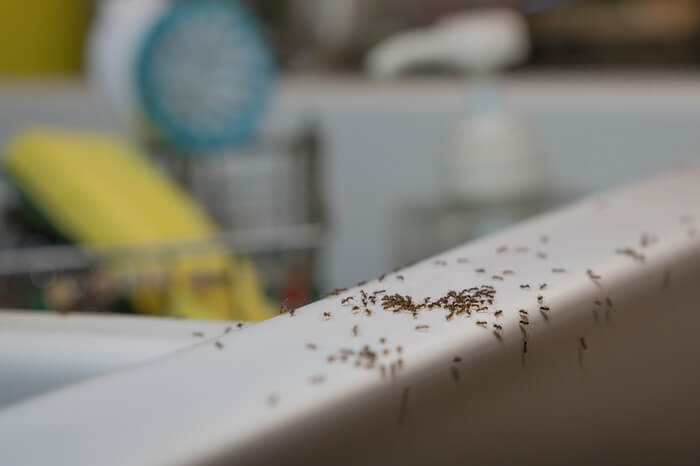
We always recommend performing inspections regularly. Homes change, and new voids can develop over time. Examining every nook and cranny will let you address issues as they pop up.
For some extra peace of mind, consider placing ant deterrents around the home. Set up some traps here and there just in case. Or, you can use all-natural repellents like aromatic herbs and sprays.
The goal is to make your home as unappealing to ants as possible! When they’re not in your home, they won’t be able to make it into your dishwasher.
Types Of Ants You’ll Usually Find In Dishwashers
Ants are more complex than most think. There is no single species that gets into dishwashers (and homes in general). There are multiple! Not only that, but each ant species acts a bit differently.
To successfully eradicate infestations, you have to know what kind of ant you’re dealing with! Here are some of the most common you’ll find in dishwashers and some tips on how to get rid of them.
Argentine Ants
Argentine ants are small insects that usually take on shades of dark brown or black. Measuring only three millimeters or so, they’re pretty tiny and can navigate tight spots with ease.
Most Argentine ants get into dishwashers by crawling through the drain pipe. However, they can also reside near leaks and damaged wood.
This species is notoriously difficult to get rid of because they form sub colonies. To kill them, you must set up numerous sugar-based traps.
Black Ants
Also known as little black ants, these insects are only one or two millimeters long. They eat a wide variety of foods. The ants will consume sugar, but they also enjoy grease and proteins.
Black ants like to live in dead wood, so rotting floors underneath a leaking dishwasher are perfect nesting spots. Plus, the presence of food grease entices them even more.
To kill these ants, you must provide multiple traps. Providing both sugar and protein-based baits will increase the chances of success.
Carpenter Ants
Carpenter ants are much larger than other species. They’re usually around a quarter of an inch long and have dark brown bodies.
As mentioned earlier, carpenter ants bore into damp wood. They chew on the wood to create tunnels and nests. Contrary to popular belief, these ants don’t eat wood. Instead, they leave behind little piles of sawdust from their excavation efforts. These ants are often found behind (or underneath) dishwashers.
In addition to traps, the best way to kill carpenter ants is with insecticides. There are many liquid and foam products that you can spray directly into the nests for instant kills.
Pharaoh Ants
Pharaoh ants are reddish-brown or yellow and measure about three millimeters long. They prefer to live in moist spaces. Often, this species will set up colonies behind a dishwasher due to the proximity to water.
Instead of relying on sand and dirt to dig tunnels, pharaoh ants use their spit. As a result, they can form nests in any void they find.
You have to be careful about treating pharaoh ants. When sprayed with insecticides, these pests split up into smaller colonies. You can inadvertently widen the infestation area if you attempt to kill them with sprays or powders.
The best course of action for success is to set up traps. Pharaoh ants eat both sweets and proteins.
Sugar Ants
The term “sugar ant” is a bit of a catch-all name. It refers to any small ant species that feed exclusively on sugary foods. Many different species fall under the “sugar ant” umbrella.
To kill these ants, provide sugar-based traps. They do well with poisoned sugar water and most commercial bait products.
Odorous Ants
These names get their name from the pungent smell they produce when squashed. Measuring about three millimeters long, odorous ants can be challenging to eradicate. Not only do they set up nests in hidden voids, but they disperse to set up small colonies like pharaoh ants.
Bait traps are the way to go with odorous ants. Luckily, their penchant for sweet foods makes getting them out of your dishwasher a breeze.
Will Ants Damage My Dishwasher?
If you’re worried about how ants damage your dishwasher, you can breathe easy. It’s unlikely that ants will do any damage to your appliance. These pests are mostly just a nuisance.
Dishwashers are made out of metal and rigid plastics. Most of the intricate parts are secure and out of the way. Even if ants gain access to the brains of the appliance, they’re not interested in chewing through wires.
These pests are after food and water. Beyond that, they’ll leave things alone.
The only exception is larger infestations. Tons of ants could clog up the drain and ruin the filter. But hopefully, you catch the problem and deal with it before it gets to that point!
Closing Thoughts
As you can see, getting rid of ants in your dishwasher isn’t as challenging as you might think. All you need to do is understand how to draw them out and then practice good kitchen habits in the future.
Let us know if you have questions about anything you read above. We’re more than happy to provide additional information.
